Microspace
The Art of
The Scanning
Electron Microscope
Dee Breger
(Columbia)
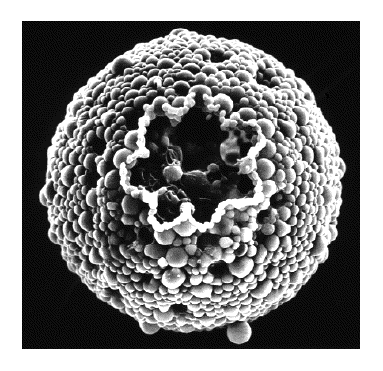
There are almost 200 photographs here. They are divided into the following categories
- Abstracts (weird patterns),
- Microscapes (even weirder patterns),
- Kaleidoscope (weird patterns in color),
- Patterns and textures (more regular weird patterns),
- Portraits (single entities).
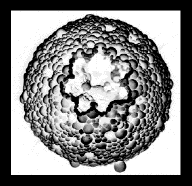 Scanning electron microscopes can be programmed to look at any tiny object almost any way, and this manipulation means that what we see is art, for the operator of the SEM can vary the micrograph with different photographic settings, film type, and darkroom techniques. The entire process is derivative because we are not seeing the object directly, we are seeing the object through the scatter of electrons. In addition, different substances emit electrons differently. Furthermore, the images we have taken from the book and reproduced here --- of tungsten, diatoms, and amoeba --- have also passed through filters to appear better on your screen (we manipulated the contrast; in addition, we flipped a couple to show them in negative form. Thus, the truth of photography, like all truths, has to pass through an operator --- and all operators introduce distortion. It's more or less the reverse Heisenberg Indeterminacy Principle, if you get my drift).
Scanning electron microscopes can be programmed to look at any tiny object almost any way, and this manipulation means that what we see is art, for the operator of the SEM can vary the micrograph with different photographic settings, film type, and darkroom techniques. The entire process is derivative because we are not seeing the object directly, we are seeing the object through the scatter of electrons. In addition, different substances emit electrons differently. Furthermore, the images we have taken from the book and reproduced here --- of tungsten, diatoms, and amoeba --- have also passed through filters to appear better on your screen (we manipulated the contrast; in addition, we flipped a couple to show them in negative form. Thus, the truth of photography, like all truths, has to pass through an operator --- and all operators introduce distortion. It's more or less the reverse Heisenberg Indeterminacy Principle, if you get my drift).
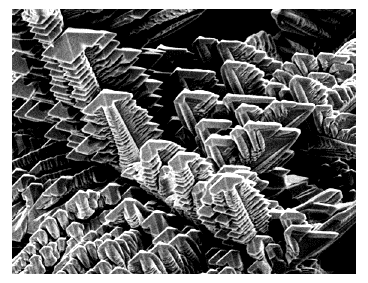 Breger points out that what she has created here is more "aesthetics" rather than "science," but whatever it is, it's wonderful. There's the Mayan Towers of tungsten (x700) to your left, the atomic mushroom cloud of a fossil pollen grain (x3,000), and three spouting volcanoes of barnacle whiskers (x500). There's an orchid which turns out to be the crystal of a kidney stone (x4,300), a jet rocket that is, in truth, a diatom (x250); there's the wheatfield that turns into the lining of an artery (x400), a cobble-stone path that's the surface of copper (x7,000), a bowl-full of breakfast cereal that is, in reality, a goldenrod leaf (x800), and a big stack of automobile tires that is "a spill of coccoliths (x9,500)."
Breger points out that what she has created here is more "aesthetics" rather than "science," but whatever it is, it's wonderful. There's the Mayan Towers of tungsten (x700) to your left, the atomic mushroom cloud of a fossil pollen grain (x3,000), and three spouting volcanoes of barnacle whiskers (x500). There's an orchid which turns out to be the crystal of a kidney stone (x4,300), a jet rocket that is, in truth, a diatom (x250); there's the wheatfield that turns into the lining of an artery (x400), a cobble-stone path that's the surface of copper (x7,000), a bowl-full of breakfast cereal that is, in reality, a goldenrod leaf (x800), and a big stack of automobile tires that is "a spill of coccoliths (x9,500)."
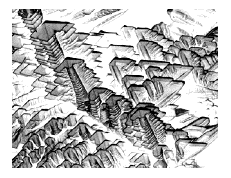 My god, it's beautiful --- and Dee Breger writes in such a way that we can understand where these glorious patterns are coming from. The black and whites seem to be the most interesting, possibly because they share the feel of early photographs --- direct, yet filled with complex patterns that beggar description: pure form, pure design, pure aesthetics. Look at the shelled amoeba (x1,000) --- at the beginning of this review --- and you are looking down on the bubbly globe of earth from 1,000 miles away. An arterial blood clot shows itself as a mess of filaments entangling doughnut-shaped red blood cells (x4,200). That space-ship from Mars is a "radiolarian" from the Caribbean (x450). Those Indian-weave blanket patterns come from a "worm tube" (x50) and the Pueblo caves in the side of the mountain are cells of petrified wood (x800). (Too bad that the SEM wasn't around when Hermann Rorschach was out looking for patterns that he could use to capture people's' fantasies. These outdo the Rorschach Test in spades)
My god, it's beautiful --- and Dee Breger writes in such a way that we can understand where these glorious patterns are coming from. The black and whites seem to be the most interesting, possibly because they share the feel of early photographs --- direct, yet filled with complex patterns that beggar description: pure form, pure design, pure aesthetics. Look at the shelled amoeba (x1,000) --- at the beginning of this review --- and you are looking down on the bubbly globe of earth from 1,000 miles away. An arterial blood clot shows itself as a mess of filaments entangling doughnut-shaped red blood cells (x4,200). That space-ship from Mars is a "radiolarian" from the Caribbean (x450). Those Indian-weave blanket patterns come from a "worm tube" (x50) and the Pueblo caves in the side of the mountain are cells of petrified wood (x800). (Too bad that the SEM wasn't around when Hermann Rorschach was out looking for patterns that he could use to capture people's' fantasies. These outdo the Rorschach Test in spades)
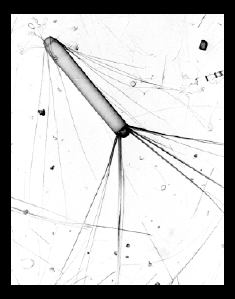 Remember when the first computer frizzled out because a moth had wandered in where it shouldn't have: it got fried, and we got our first electronic "bug." Breger gives us a similar one here on Plate 2.9, "Surface detail on an anonymous bug that wandered into the home of the microscopist and was prevailed upon to donate itself to Science (x1,100)."
Remember when the first computer frizzled out because a moth had wandered in where it shouldn't have: it got fried, and we got our first electronic "bug." Breger gives us a similar one here on Plate 2.9, "Surface detail on an anonymous bug that wandered into the home of the microscopist and was prevailed upon to donate itself to Science (x1,100)."
If the captions aren't enough, the "Sources and Stories" has additional, and fascinating, information. For example, this, with lovely shots of those guys who kept you up all night:
- The wings of a mosquito are its primary steering mechanism and the "hairs" and "feathers" are probably used for better control over its flight.
Scientists can put those dull-bulb astronauts on the moon, get a $4,000,000,000 trash-bucket out there next to Antares, but they have yet to invent a whine-free mosquito ... one with mufflers and noise-controllers. I don't care if it wants to sup on my blood, I just don't want it singing love-songs in my ear at 2 A.M. Breger explains why in her notes to what she calls "the mosquito wing series:"
- ...mosquitoes use the sound produced by flight as part of their courtship. The various structures on the wings may be part of a species-specific instrument that sings the appropriate courtship song.
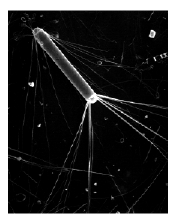 Journeys in Microspace is a dandy. It comes from Columbia University Press, and was originally published at $39.50. Breger has written for Scientific American, The New York Times, and, alas, The Reader's Digest --- but it doesn't seem to have hurt her clarity and expert writing style at all.
Journeys in Microspace is a dandy. It comes from Columbia University Press, and was originally published at $39.50. Breger has written for Scientific American, The New York Times, and, alas, The Reader's Digest --- but it doesn't seem to have hurt her clarity and expert writing style at all.